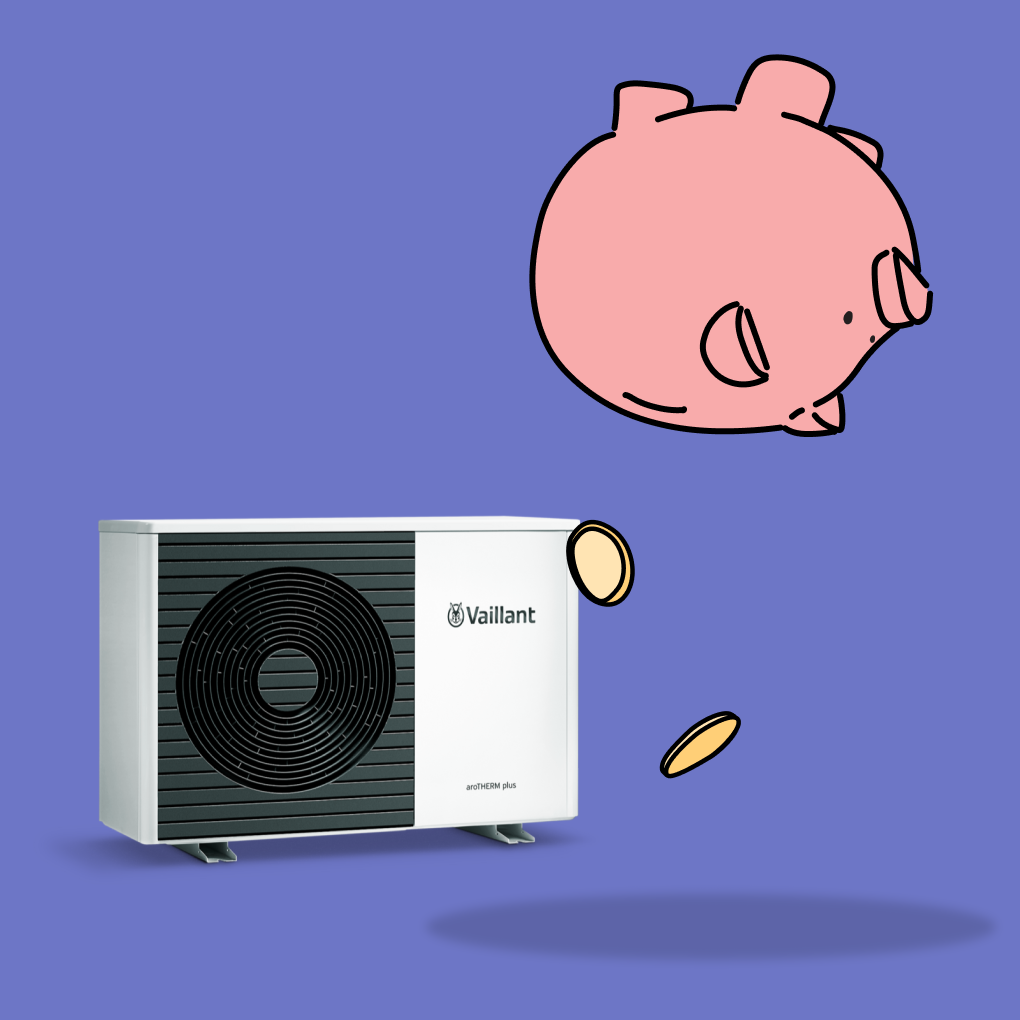Cost of an air source heat pump
An air source heat pump in 2025 costs between £3,000 and £12,000. This cost is for the purchase and installation of the heat pump itself. However, many homes will require additional insulation and radiator upgrades to get the system to work effectively.
We’ve summarised the costs below. Read on further down the page to see each cost explored in more detail as well as some actual real examples of air source heat pump cost in 2025.
| Type of system | Type of heating | Grant available (UK)? | Typical cost |
| Air to air | Rooms only (no water) | No | £3,000 |
| Air to water (standard) | Rooms and water | Yes | £10,000 |
| Air to water (high temp) | Rooms and water | Yes | £13,000 |
Additional costs depending on the age of the house, type of system etc
| Type of upgrade | Required? | Typical cost |
| Radiator | Maybe | £3,000 |
| Cavity wall | Maybe | £1,500 |
| Loft insulation | Maybe | £600 |
| Heating pipework | Maybe | £3,000 |
| Cylinder | Maybe | £2,000 |
| Windows | Maybe | £7,500 |
| Underfloor heating | Nice to have | £10,000 |
Methodology
We used a number of research sources to write this article. These included the following:
- The Energy Savings Trust
- Figures from the Government’s Boiler Upgrade Scheme
- Figures from heat pump manufacturers
- Figures from heat pump installers
We then had our team check the figures to make sure they are up to date.
Installation costs vs running costs
The first thing to understand when considering air source heat pump cost, is what kind of expenditure we are talking about. Broadly speaking, the costs of the system break down into two categories.
- Installation costs – the costs needed to install your air source heat pump so it works as efficiently as possible
- Running costs – the monthly costs you’ll be spending to run the system and provide heat and hot water for your home
It is true that there is often a significant outlay on installation when switching to an air source heat pump. And although there are government grants available to help with this cost, it is important that home owners understand what factors influence this number.
As far as running costs are concerned, these are where homeowners will save money. If you perform the installation correctly, with all the required radiator and insulation upgrades, your air source heat pump will be much more efficient than a conventional gas boiler. Of course, how much you invest in your installation will determine how much money you will save each month, so the costs are very much related.
In this article we will first take a look at each of these costs in turn. We will then look at four different types of houses we commonly see in the UK and provide a breakdown of what potential installation and running costs might be.
Heat pump installation costs
What is the size of your home?
Setting aside the energy efficiency of your home for a moment, two factors are going to influence your household energy requirements. How large your property is (home size) and how many people are living in it. Whether we are talking about cold climates or warm climates will also have an effect on the heat pump required.
Heat pumps come in different outputs and different sizes. Not surprisingly the ones with the bigger outputs tend to cost more. They are more suited to larger homes which require a larger amount of heat.
There are some quite complicated maths that is used to work out the heating required in a home. On a very basic level (laid down in the building code), one kilowatt of heat is required for each 10m2 of your home. Thus for an average family home in the UK of 130m2, around 13,000 kilowatt hours (kWa) will be required. There is a a bit more to the calculation than this. We also need to take into account other factors – including the type of house, the room height, the number of windows and doors and the climate zone. But we will go into this in a bit more detail later on.
What type of heat pump do you want to install?
It’s not just the size of the heat pump that affects the cost. The type of air source heat pump will also affect how much you will spend.
The two types of air source heat pumps are air-to-air pumps and air-to-water pumps. Both types use heat from the outside air to heat your house. Both types require an outdoor unit and indoor unit. However, they use the heat in very different ways once it’s passed through the compressor. The differences mean that their cost and their effectiveness can vary hugely.
Air-to-air pump systems
Air-to-air pump systems take heat from the air outside your house, compress it and then distribute it within your home via hot air.
They are very well suited to open plan homes. Air can circulate easily throughout the whole property, rather than being confined to the room where the heating fan is located.
They may not work as well in traditional homes with smaller rooms. The heat may not be distributed as effectively from room to room as less air will circulate between them. You may require multiple heating units if you wanted to rely on an air-to-air system to heat your entire house. For this reason, many homeowners use this type of pump as an additional heating system. They run it in conjunction with their current system, rather than replacing it entirely. Some units will require a duct system to work effectively.
Air-to-air heat pumps are also well suited to properties which require a cooling system the in warmer months. They can run in reverse, absorbing the heat in your property, and pumping it outside. This is similar to an air conditioning unit.
An air-to-air system is not be sufficient to heat the entire property for most homeowners. But they are a great solution for customers hoping to reduce their heating bills without replacing their whole heating system. By heating one or two rooms of the house much more efficiently using an air-to-air pump system, homeowners can become less reliant on their traditional heating system. They can reduce their overall energy consumption and, in turn, their energy bills.
Air-to-water pump systems
Air-to-water heat pumps work a bit more like a traditional heating system. They provide heating for the rooms in your house via radiators and/or underfloor heating pipes. They also provide domestic hot water for taps and showers.
Rather than warming the house through a fan system, like air-to-air pumps, air-to-water systems transfer heat from the air outside your home into water inside. This water then supplies central heating and taps throughout the house.
Air-to-water heat pumps are much more versatile than air-to-air heat pumps. They are able to heat your home through a full central heating system. This means that regardless of the style of your house – open plan or more traditional – an air-to-water heat pump can evenly supply heat throughout using radiators and underfloor heating pipes in their current positions.
For this reason, they are more widely used for heating homes than air-to-air heat pumps. However, if you require a system which can also provide cooling during the summer months, air-to-water systems are not able to provide this.
The relative costs
Typically an air to air system will cost around £1,500 to £3,500 to install. This will include a new heat pump and the labour costs of a heat pump installer.
An air-to-air system only heats up a living space. It does not provide hot water. It is therefore much cheaper to install than an air-to-water pump system. As the system usually works alongside another existing heating system, the installation is relatively fast and simple to achieve. However, new ductwork can be expensive and impractical in older houses.
Air-to-air heat pumps have a shorter lifespan than air-to-water systems. They last around 10-15 years on average. But with their cheaper price point for installation and purchase, this may not be an issue.
The average cost to buy and install an air-to-water system is significantly higher than an air-to-air system at between £5,000 and £12,000. This includes the purchase of the heat pump, and it’s deployment by professional installers. The system is much more complex and requires a larger scale unit to process the heat. It also needs to link up to your existing central heating system.
What home upgrades are required
The UK has a very varied housing stock when compared with other industrialised countries. Much of it is old and dates from the Victorian period or even before. According to the National Statistics Agency 2021-2022 Housing Stock Report around one in five private dwellings were built before 1919. Private dwellings built after 1990 accounted for just 20% of the national stock.
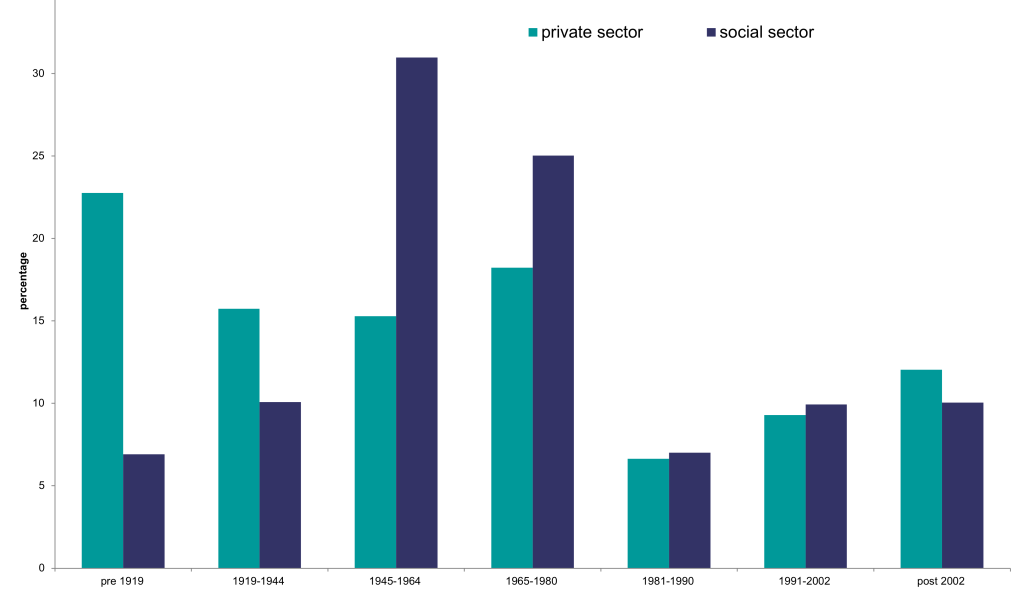
Because of the age of our housing stock, a lot of it has a very poor energy efficiency performance. This was less of a concern in the era of cheap, fossil fuel energy. But with global warming and energy price inflation, we are now much more focussed on how we conserve energy and heat in our homes.
When you upgrade to an air source heat pump, you’ll be installing a heating system that is much more efficient to run, but it does come with some trade-offs. Engineers design air source heat pumps to run in modern, energy efficient homes. If your house is of a certain age, or certain construction, some upgrades may be required to make the system run optimally. These can increase the price of installation quite significantly.
Let’s examine these a bit further:
Radiator upgrade
A gas boiler will typically run at 65°C. This means it will circulate water at 65°C throughout your home. Although some air source heat pumps can run at these temperatures, you’ll generally get better results running them at 40°C to 45°C.
The issue with this is that the water inside the radiator will be around 25% cooler than with a gas boiler system. To get your house to the same temperature, the radiator needs to allow more heat convection. In short it needs to be more powerful.
Not every house will require a radiator upgrade. In fact, engineers often over spec radiators for houses even when they install a gas boiler. But it is one of the most common upgrades required when you install an air source heat pump.
We’ve written a longer article on radiators and air source heat pumps here which goes into more detail.
Underfloor heating
Water based (wet) underfloor heating works beautifully with air source heat pumps as it distributes low heat over a large area in your home. It provides a constant temperature in a room and saves on radiator floor space. You might consider it the Rolls Royce of heat distribution systems.
The main issue with underfloor heating is that it can be very disruptive to install. If you’re building a house from scratch, or doing a large scale renovation project then you should definitely consider it. However, it you’re just looking to switch over your heating system it may not be practical.
Again, we’ve written a longer article which goes into more detail on this.
Insulation upgrades
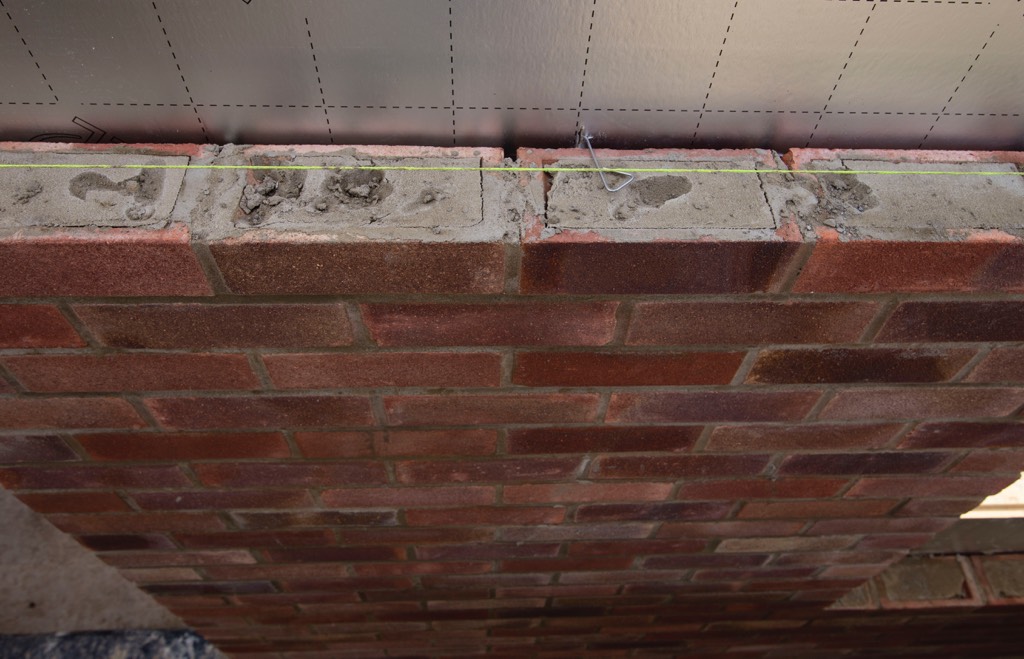
It’s not just how heat is generated and distributed that will affect things. The other part of the equation is how much heat is lost and how much retained in your home. One of the big factors that affect this is how insulated your house is.
There are different types of insulation in homes but we will look at three types here. Wall insulation, loft insulation and windows and doors:
Loft insulation
Loft insulation is a bit of a no-brainer. According to the Energy Saving Trust, a quarter of heat is lost through the roof in an uninsulated home. Generally speaking loft insulation is a very affordable and straightforward way to get your home to retain more heat and save money on your monthly bills.
It is rare that a home in the UK has no loft insulation at all. But modern insulation recommendations are much higher than many homes currently have. The requirements for new homes is 250mm of insulation, although the optimum levels are closer to 270mm. Many homes with lofts that were insulated several decades ago will only have 120mm. This may not be sufficient to run an air source heat pump effectively.
Wall insulation
Engineers design Modern houses with cavity wall insulation on the outside walls. In short, the brick layer creates two walls with a gap between them. This gap is then filled with insulation. The result is a very thick, warm layer that retains heat inside the house, and prevents cold from entering.
Cavity walls became common place after the 1920s, and insulation between the two walls became commonplace after the 1970s. Insulated cavity walls became compulsory for new houses in the 1990s.
If you live in a house built since the 1990s you will almost certainly have insulated cavity walls.
If you live in a house built prior to 1919, it’s likely that your house was built with just a single outside wall (single skin). These have much poorer heat retention. Because an air source heat pump does not pump out as much heat as a traditional gas system, the loss of heat through single skin walls will be much more noticeable.
If your house was built after 1919 but before the 1990s, you may have cavity walls with no insulation – essentially just an air gap between the two walls. Whilst these are more energy efficient than a single skin, the performance will not be as good as fully insulated walls.
There are some options to upgrade your insulation. With single skin walls, you can build extra insulation on the inside of the house or the outside but as with underfloor heating, it can be quite disruptive.
With non-insulated cavity walls, you may be able to install insulation. There are specialist firms that do this, normally by injecting insulation into the cavity.
Windows and doors
The UK government estimates that around 18% of heat loss occurs through windows. While double glazing has become standard over the past few years in construction, across the UK it’s estimated that around 7% of households have no double glazing.
Again, the older houses are usually the worst offenders. If you live in an older property with single glazed windows you should strongly consider replacing them with double glazing before installing a heat pump.
The performance of double glazing has improved massively since it was first introduced in the 1980s. So even if you do have double glazing, if the windows are older it still may be worth getting them replaced.
If you own a period property or live in a conservation area, there are number of alternatives to PVC windows that still perform well on energy efficiency.
It surprises many people to learn that doors can be must worst offenders of heat loss the windows. If the doors are unsealed, or badly installed air can leak through the gaps. Heat can also escape through the door itself.
If you have old, or badly fitted doors, replacing them is a great option, and will certainly help your heat pump run more efficiently. If you don’t have the budget for replacement then it might be possible to improve their energy efficiency by installing draft proofing around the existing door.
Heat pump running costs
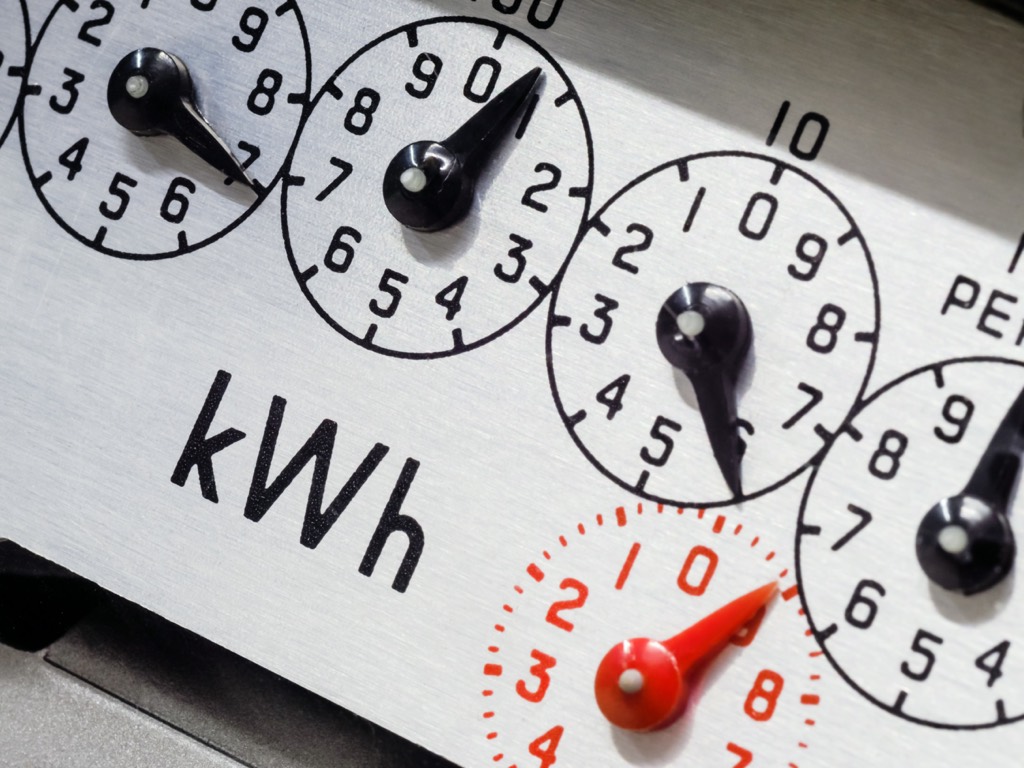
OK so you’ve got a rough idea of how much you’ll be spending on installing your air source heat pump. Now let’s look at how much you might save on your monthly bills. In this article we will only touch on running costs. We have a much longer article which examines this in a lot of detail.
Efficiency ratings
Before we do that we need to introduce something called the Coefficient of Performance (CoP). The CoP expresses the efficiently of energy output of a device. It is calculated by dividing the amount of energy produced by the energy consumed.
This is a useful measure when calculating efficiency on a one-off basis. However, for air source heat pumps a more accurate measure is SCoP – the seasonal coefficient of performance. This takes temperature fluctuations into account to give an average efficiency for the whole year.
Seasonal energy efficiency ratio
Air-to-air heat pumps have a SCoP of 3.5-5, meaning that they produce 3.5-5 times more energy than they consume. This is incredibly efficient, especially when compared with the average CoP of 0.9 for a traditional heating systems.
The average SCoP for an air-to-water heat pump system is 2.5-4, meaning that they produce 2.5 to 4 times more energy than they consume. This figure is lower than the SCoP for an air-to-air heat pump. But comparing the SCoPs of the two side by side is not a fair comparison. An air-to-air heat pump is unlikely to be supplying the heating for the entire home. The overall CoP of a house using a combination of air-to-air heating alongside a traditional boiler will be much lower than that of a house using an air-to-water heat pump system alone.
Running an air source heat pump system is not 100% carbon-free, as the pump equipment itself uses electricity. However, the high efficiency of an air source heat pump means that the same amount of electricity can produce 2.5-5 times more heat than a traditional boiler system.
Energy use
We stated at the beginning of this article that an average family home of 130m2 will use around 13,000 kWa for heating needs. In colder climates this might be more and in warmer climates less. However this does give us a good benchmark to calculate what the running costs of a heat pump unit might be.
Energy cost
At the time of writing (Apr 2025), The Energy Saving Trust has put the average cost per hour of electricity at 24.5/kWa. Assuming our heat pump is generating 3 times as much energy as it consumes our annual bills should be around £1,061 (plus standing charges)
13,000 KWA requirement x 300% efficiency x 0.245 kWa price.
It’s important to bear in mind that we are going through an energy crunch at the moment with the price of electricity at an all time high. Electricity prices are expected to fall in the coming years and your monthly savings should increase as this happens.
Figures below from the Energy Savings Trust estimate the difference you could see in your annual energy bills (Jan 24). These figures are based on installing a standard air source heat pump in a three bedroom semi-detached home, with radiator upgrades as required.
|
Current heating system |
Annual Savings |
| Old (G-rated) gas boiler | £290 |
| New (A-rated) gas boiler | Cost neutral |
| New electric storage heaters | £700 |
| Old electric storage heaters | £1,200 |
| Old (G-rated) LPG boilers | £650 |
Examples of actual air source heat pump cost
If you’ve made it this far, well done. We’ve attempted to cover air source heat pump costs very thoroughly in this article, but in order to do that we’ve had to get a bit technical. Now let’s put it all together.
We will examine four types of homes typically seen in the UK and how much an air source heat pump might cost to install in each, including all necessary upgrades. Of course, these are theoretical figures, but they should give you some idea of what it would cost to install an air source heat pump in your home.
1) The modern house
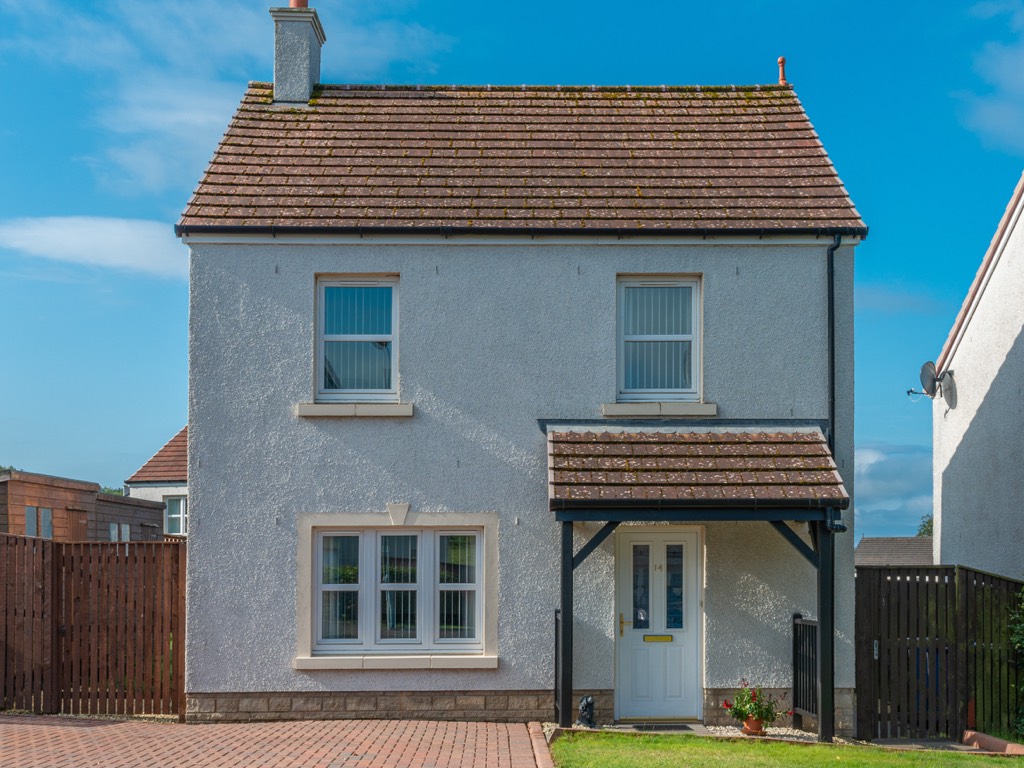
Jada lives in a modern detached 3 bed house which she bought as a new build five years ago. The house is well insulated with 100mm insulated cavity walls and well-sealed PVC doors and windows.
Although the house was sold with a gas boiler, the radiators have been over specified for the property. After consulting with a surveyor, who runs some calculations, Jada decides to keep the radiators as they are. She chooses the Daikin Altherma 3 HT3 which is a high temperature heat pump. The heat pump is on the more expensive side, but is suitable to replace a traditional heating system.
Jada’s cost breakdown
Air source heat pump purchase and insulation £9,800
Total cost £9,800
2) 1970s bungalow
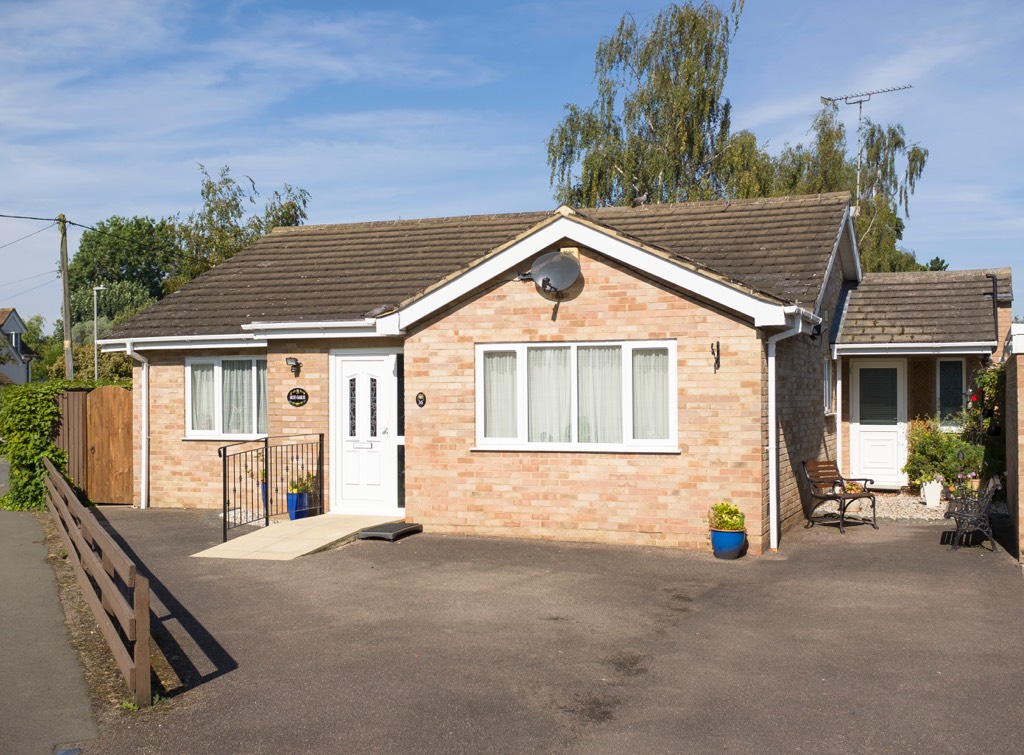
Darius lives in a 1970s bungalow. He is keen to install a heat pump to save money on his monthly bills.
The bungalow was one of the first homes to be built with cavity wall insulation. The cavity is 50mm thick (much thinner than modern homes) with only 25mm of insulation. However, Darius does not want the disruption of installing internal insulation and decides to keep the external walls as they are.
The bungalow already has reasonably modern double glazing and doors which Darius decides to keep. The loft has 250mm of insulation which Darius decides will be sufficient for his needs.
Darius chooses a heat pump from the NIBE range, which are great for smaller properties. In order to maximise the heat distribution from the heat pump he decides to replace his normal radiators with low temperature ones.
Darius’s cost breakdown
Air source heat pump purchase and installation = £8,500
Radiator upgrade = £2,100 (7 x radiators)
Total cost = £10,600
3) 1930s semi-detached
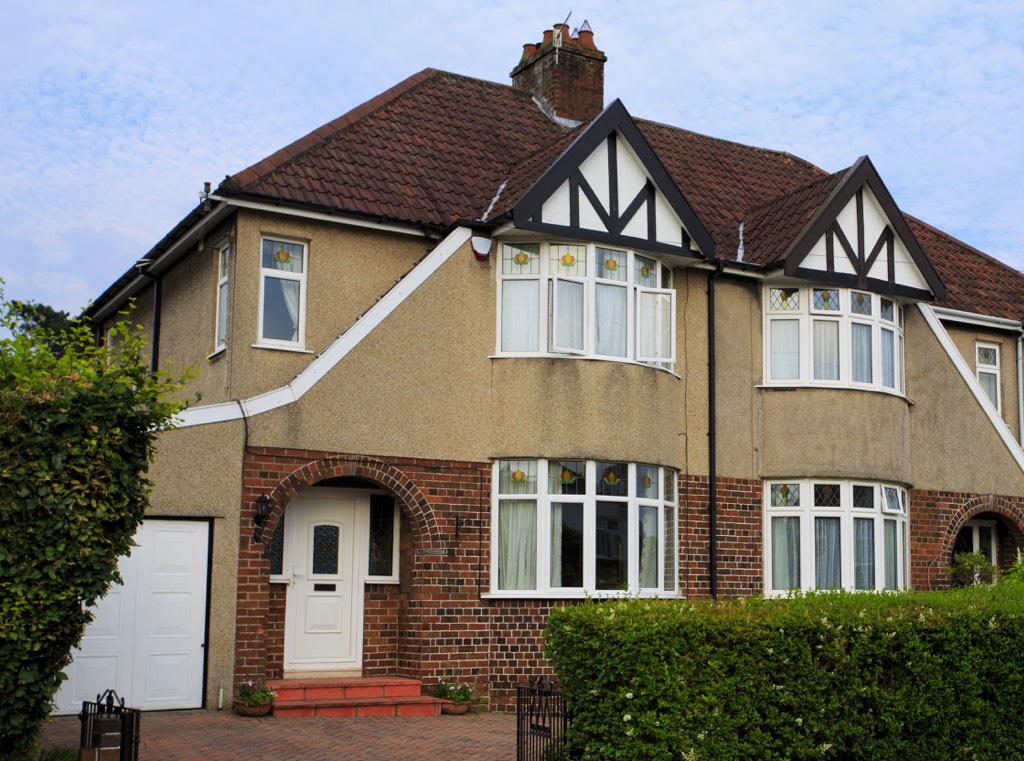
Mary lives in a 1930s semi-detached house. Her gas boiler is coming to the end of its life and Mary decides to replace with a an air source heat pump.
As she lives in a colder part of the country she opts for the Samsung Eco Heating System, which can operate in temperatures as low as -25°C. This heat pump is a low temperature heat pump however and requires Mary to upgrade her radiators to low temperature models.
Even though it was done ten years ago, Mary already has double glazing installed. She decides to leave the windows as they are. Like Markus, she has 120mm of insulation in her loft which she decides to upgrade to 270mm.
Mary’s house has uninsulated cavity walls. She decides to have insulation injected into the cavity to help her home retain heat and make the heat pump more cost effective.
Mary’s cost breakdown
Air source heat pump purchase and installation = £10,000
Radiator upgrade = £3,000 (10 x radiators at 300 each)
Cavity wall insulation = £1,500
Loft upgrade = £600
Total cost = £15,100
4) Victorian terraced house (full renovation)
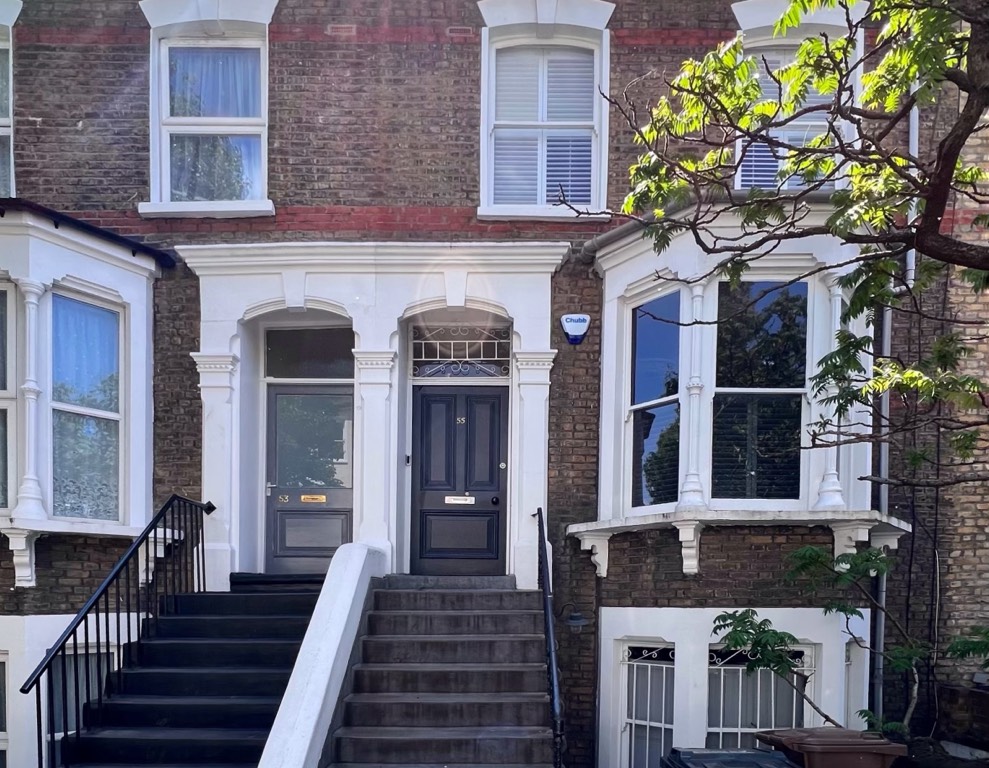
Markus has just bought a Victorian terraced house in South London. The house was quite run down when he bought it and he is planning on doing some extensive renovations before he moves in with his family.
Markus would like to install an air source heat pump to cut down on his carbon footprint. He knows that some of the upgrades required will be very disruptive so chooses to do them while the renovation work is taking place.
Markus plans to install the pump unit in his front garden. As he wants it to be as quiet as possible he picks the Vaillant aroTHERM range.
Markus decides he wants to go the whole hog for efficiency. He installs underfloor heating in the ground floor of this house, and replaces the existing radiators with low temperature models on the first floor. Markus also decides to replace his old single glazed windows with double glazing. He chooses traditional sash style windows on the front of his house, and PVC on the rear.
The exterior walls of Markus’s house are made up of 9 inch single skin brick, with poor heat retention. After some consideration Markus decides to install internal insulation on the inside of the exterior facing walls. He also decides to upgrade his loft insulation from 120mm to 270mm.
Markus’s cost breakdown
Air source heat pump purchase and installation = £10,000
Internal wall insulation = £8,500
Window upgrade = £7,500
Underfloor heating = £10,000
Radiators upgrade = £2,500
Loft insulation upgrade = £600
New heating pipework = £3,000
New unvented cylinder = £2,000
Total = £44,100
Government figures on air source heat pump cost
The UK government publishes figures from its Boiler Upgrade Scheme. These include the cost of air source heat pump installation which applicants to the scheme report. The mean (average) cost of air source heat pump installation in England and Wales between May 22 and Jan 24 was £13,339. The average cost for the bottom 25% (bottom quartile) of installations was £10,998.
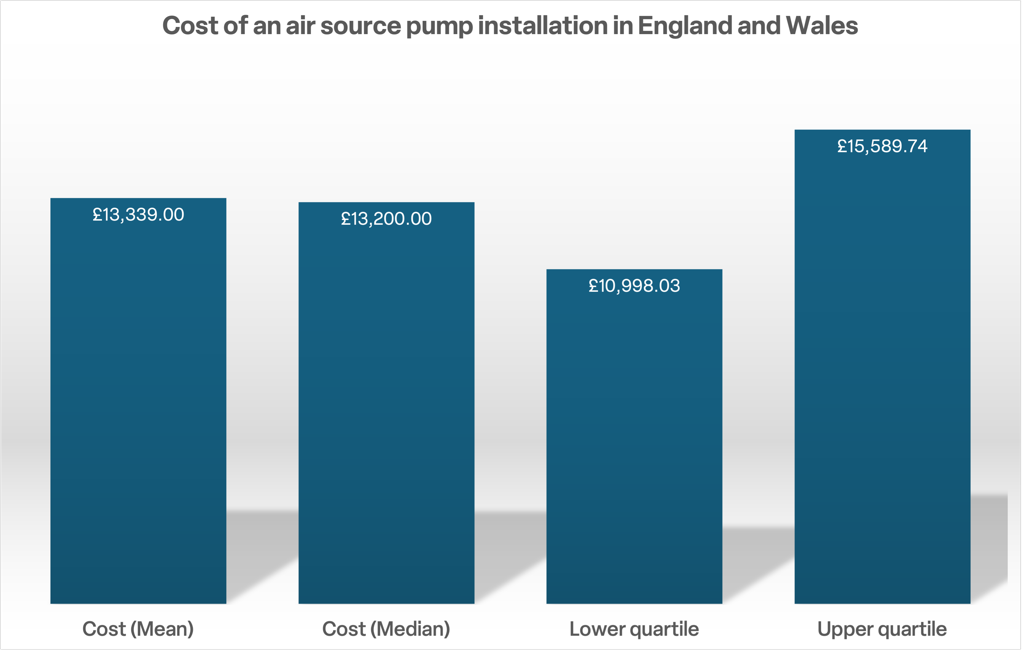
Air source heat pump cost – in summary
So as we can see, providing a simple cost to install an air source heat pump is not a simple matter. We’ve tried to break down some of the complexity in this article and to illustrate this with real world examples.
Although some costs may seem daunting. Don’t forget that there is help at hand. The UK Government have realised the potential of air source heat pump systems and are encouraging homeowners to convert their heating system offering a number of grants and tax credit schemes. These help with the initial financial investment of installing and running an air source heat pump.
There are various grants available through schemes such as the Boiler Upgrade Scheme and the Energy Company Obligation. You can find more information on these in our comprehensive guide to grants for heat pumps.
